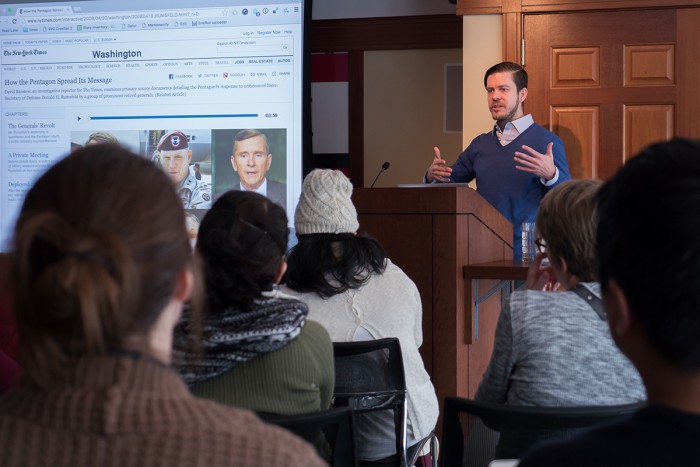
Editor’s note: There are a lot of great stories to read in the newest issue of our sister publication Nieman Reports. In this piece, a transcript of a talk given here at Lippmann House, Marshall Project managing editor Gabriel Dance talks about the evolving relationship between media and technology, Facebook, and the importance of collaborators in the newsroom.
At The New York Times, where I was on the team that did some of the first experiments with streaming video, interactive graphics, and user-generated content, the people I met fit in one of four categories, technologically speaking. The Natives — like Aron Pilhofer, Derek Willis, Scott Klein, and Andrew DeVigal — are people who already understood the implications of technology. The second group is the Naturals, people like Jim Roberts. When I arrived, Jim, who’d already been there for 20 years, was head of the digital newsroom. He was as old-school journalist as you could get. Jim was not operating from a place of fear; he was operating from a place of excitement. He saw the potential in everything, even though he didn’t understand almost any of it at the beginning. He surrounded himself with smart people and people who he thought would help him learn.
I like to call the third group the Collaborators. They are my favorite group to work with. They are not necessarily interested in learning how to program, do databases, or do the interactives themselves, but they’re excited about working with people who are good at those kinds of things in order to do better projects. They often cause me to have ideas I never would have had. Collaborators are often very good at what they do, so they don’t feel threatened by another person coming in saying, “I want to do work with you.” The last group I met I call the Fearful. That’s a dangerous group to be in. The Fearful operate from a place of fear: They’re not sure what’s going on, they’re not sure how they’re going to keep their job, they’re not sure of the new technology.
The video landscape is hypercompetitive nowadays. Video also has one of the few advertising schemes that is still paying dividends. The problem is, it’s super hard to crack.
There are two things I find interesting about video. One is virtual reality, such as Oculus Rift. It’s very immersive. That’s going to be a tremendously interesting place for video. The other thing is social media. Video is going crazy on social media, which is dominated by things like Facebook, and I can’t overemphasize how important Facebook is right now to journalism. Websites get huge amounts of their traffic through Facebook. It can turn switches off and on that either reduce that traffic to a trickle or open the spigot to a fire hose.
The Marshall Project, in partnership with ProPublica, recently published An Unbelievable Story of Rape, written by Ken Armstrong and T. Christian Miller. It was an interesting, long, complicated, wonderfully written investigation into a woman who said she was raped, then said she wasn’t raped, and the subsequent police investigation around that. We built a 30-second video teaser for Facebook, which got very little attention. Yet the story got crazy good traffic. I think the story is probably the most popular thing The Marshall Project has ever published. It happens to be one of the best things we’ve published, but things get crazy traffic for a variety of reasons. What we took away from the experience is that creating content for Facebook or Snapchat — or whatever — needs to be content for that particular platform. People on Facebook didn’t engage with our video in a way that says, “Oh, here’s a teaser. Let me follow that teaser back to the website.” They will watch your video on Facebook, and they want to stay on Facebook and finish consuming it there or stay on Snapchat and finish consuming it there. That’s fine, especially for a nonprofit like The Marshall Project. We don’t care where you see our content because we don’t do advertising.
What we’ll need to do is hire somebody to produce content specifically for these platforms. That is a real skill, and it’s not the same skill as writing an 800-word story or a 5,000-word story. It’s not the same skill as producing a 10-minute documentary. It’s not the same skill as doing an interactive graphic. It’s a skill of knowing how to engage people, knowing how to quickly get their attention and maintain it, by knowing what they’re interested in.